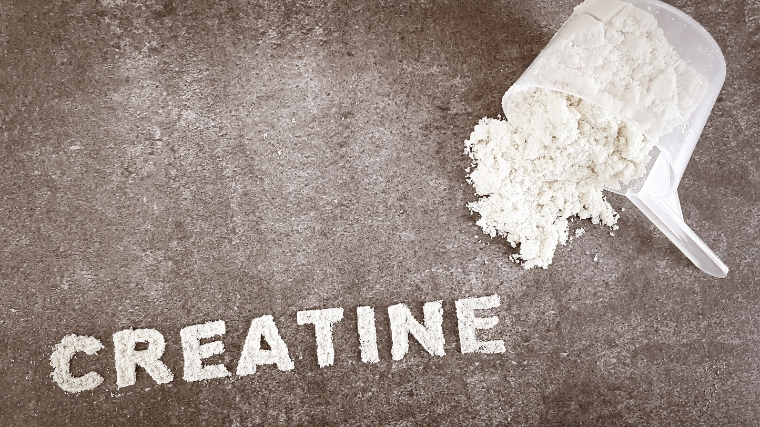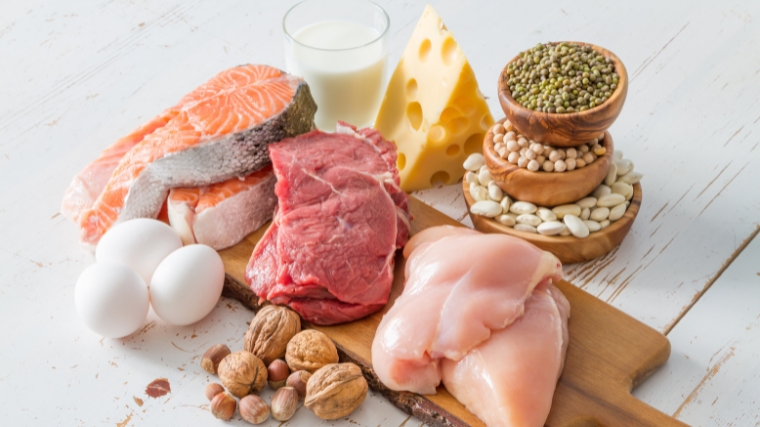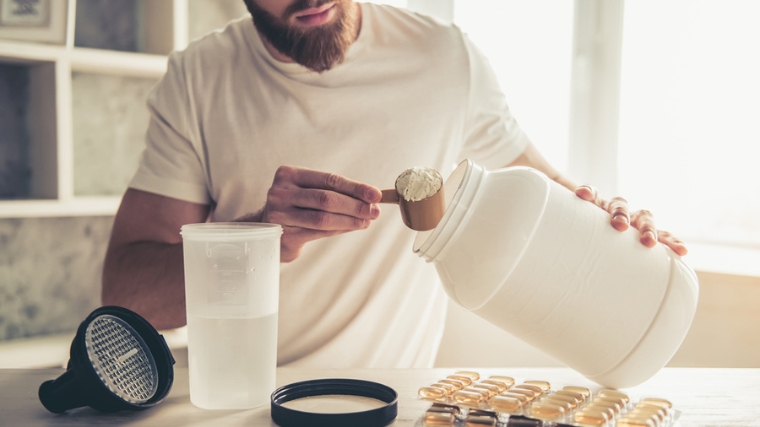You may know creatine as that powder your gym buddies scoop into their pre-workout. It’s an amino acid that naturally exists in your body and is key in producing energy for short bursts of intense activity.
There’s a reason athletes, from CrossFitters to bodybuilders, use the stuff. Supplementing with creatine has potential benefits for lifting — and your overall health — including your brain, blood sugar, and ability to fight diseases. But if you’re not interested in supplements, you can get your creatine in food.

Foods with creatine are often high in protein and other nutrients, so you may already include them in your diet. High-creatine foods come from animal sources, including red meat, seafood, and some dairy. But if you don’t eat meat or dairy, don’t despair — for vegans who want to know how to increase creatine naturally, there’s a trick for you, too. It starts with the science of amino acids — so let’s dive in.
Editor’s Note: The content on BarBend is meant to be informative in nature, but it should not be taken as medical advice. When starting a new training regimen and/or diet, it is always a good idea to consult with a trusted medical professional. We are not a medical resource. The opinions and articles on this site are not intended for use as diagnosis, prevention, and/or treatment of health problems. They are not substitutes for consulting a qualified medical professional.
What Is Creatine?
If you want to get natural creatine, the good news is that this amino acid is already stored in your body in your skeletal muscles. Your body forms more creatine by combining three other amino acids: arginine, glycine, and methionine. (1) When you ingest creatine, it goes into your cells as creatine phosphate, a phosphagen.
Having more phosphagens in your system can boost your level of ATP, or adenosine triphosphate, also known as energy’s currency. (2) When you do high-intensity exercise, including powerlifting or sprinting, your ATP gets you through it. When ATP burns out — in two or three seconds — having stored phosphagens can help keep you going longer.
Whether you want more creatine to increase your training gains or reap other health benefits, let’s look at some sources of creatine.
Natural Sources of Creatine
Creatine is a carninutrient, which means it’s only available to adults through animal foodstuffs. (1) It’s estimated that human creatine levels were higher in Paleolithic times than today because humans mostly ate animal-based food. (1) The original paleo diet was rich in creatine.

Infants that receive milk through breastfeeding or milk-based formula get some natural creatine. (1) For adults that eat meat, you can add foods high in creatine, including red meat, poultry, and seafood. If you are vegetarian, there is some creatine in cheese and a little less in milk. Unfortunately for vegans, there aren’t any foods containing creatine you can eat.
However, vegans can still encourage creatine synthesis by ingesting foods with the amino acids arginine, glycine, and methionine. (1) Eating certain seeds and beans with these amino acids is how to get creatine naturally.
Creatine Supplements
Creatine can also be ingested through supplements. For vegans looking to boost their creatine levels, supplements may be the most efficient way. You can opt for vegan supplements containing natural ingredients.
Although it’s not food per se, supplements are the most significant sources of creatine for vegans.
Benefits of Creatine
The potential benefits of creatine range from increasing training gains to overall health. Studies consistently suggest that increases in intramuscular creatine concentration can help boost strength, muscle growth, and recovery. (3) It’s also been shown to improve your brain health and fight other diseases. (3)
May Boost Strength Gains
When it comes to creatine and strength, the benefits come are all about high-intensity, short-duration exercise. Think about hitting your one-rep max on a deadlift or a short, fast sprint. Research shows that creatine intake enhances training adaptations. (3) These adaptations allow you to do more work. More work can lead to strength gains in the long run. (3)
This is due to the quality of your training improving. When you have more energy from more ATP, you may be able to lift a little heavier for a little bit longer and maintain your perfect form. Add all those little improvements together, and they significantly impact your entire training cycle.
May Increase Muscle Growth
If your fitness goal is hypertrophy, many studies have shown that supplementing with creatine can help you build muscle mass. (4) Most studies are on taking creatine supplements in conjunction with your training program.

[Read More: Powerbuilding Workout Routine, With Tips from a CPT]
Therefore, to reap the maximum benefits of creatine for muscle growth, you’ll want to ensure you’re using it in tandem with strength training. This way, all that extra potential energy has somewhere to go — directly into fueling those muscle-building workouts.
May Improve Recovery
Getting adequate creatine in your diet has been shown to enhance post-exercise recovery, as it helps to replenish your glycogen stores after training. It may help reduce inflammation, decrease soreness, and prevent injury. (3)
Research shows this may work when you include creatine supplements in your pre-workout. You can opt for a natural pre-workout alternative to avoid supplements by ingesting a small meal, smoothie, or snack.
You can include some natural creatine sources in your pre-workout meal, but allow yourself time to digest. If you’re having a post-workout meal, that may be a better time to include some creatine in meat. Getting protein and carbs in your post-exercise nutrition is shown to promote recovery, so it may be a good spot to try adding some food with creatine as well. (5)
May Improve Glucose Management
Aside from training benefits, creatine may offer other health boosters. Research has shown that creatine intake — specifically when combined with exercise — may improve glucose metabolism in both insulin-resistant individuals and nonresistant folks. (6)
A study on people with type-2 diabetes showed that creatine combined with exercise improved glycemic control. (7)
If you have diabetes and want to try adding some food with creatine to your diet to help manage your blood sugar, it’s always best to consult a doctor first.
May Boost Brain Health
While 80 percent of creatine is stored in your skeletal muscles, 20 percent of creatine is stored in your brain. Recent research suggests that creatine may benefit brain health regarding cognitive processing, brain function, and recovery from trauma. (8)
Research on creatine and brain health notes that the optimal creatine intake protocol is still to be determined. (8) So, including foods with creatine in your diet may help boost your brain health, but more research is needed.
May Fight Other Diseases
In addition to exercise, studies consistently show the benefits of creatine supplementation for fighting other diseases, such as diabetes.
The conditions include neurodegenerative diseases like muscular dystrophy, Parkinson’s, Huntington’s disease, osteoarthritis, fibromyalgia, brain and heart ischemia, and adolescent depression. (3)
In addition to fighting diseases, creatine has been shown to help boost cognitive function for people with conditions like traumatic brain injuries, Alzheimer’s, and depression. (8)
Best Foods With Creatine
What foods have creatine in them? Lots of them — but they are all from animal sources. Below is a creatine-rich food list, from red meat to poultry to fish to dairy. But before you start drawing up your shopping list, a few notes:
Although creatine can also be found in other animal foods not listed here, the following food sources of creatine contain at least two grams (or more) of creatine per serving.
The creatine amounts listed per kilogram below are in uncooked meat and fish. When you cook them, they may lose a lot of their creatine. (9) The exact amounts are not confirmed by research, and different cooking methods may affect it.
One might assume that the exact amount could be between the milligrams in cooked food and grams in uncooked food. Since this is imprecise, creatine supplements may be the most straightforward approach if you want to track and increase your creatine.
Supplements remain the best source of creatine for vegans, but there’s still a natural way to source creatine for them.
[Read More: Best Tasting Protein Powders, Tested and Reviewed by Our Team]
Here are foods with relatively high levels of creatine (and vegan foods with creatine components).
- Steak
- Ground Beef
- Chicken
- Herring
- Salmon
- Tuna
- Cod
- Parmesan Cheese
- Pumpkin Seeds
- Sesame Seeds
- White Beans
- Walnuts
- Almonds
- Watercress
Steak
Different cuts of red meat have some of the highest creatine levels you can get in animal products.
Steak has five grams of creatine per raw kilogram of meat and approximately 500 milligrams per cooked serving. (9) A three-ounce serving of steak has 25 grams of protein and 7.6 grams of fat. (11)
Ground Beef
Ground beef has 2.5 grams of creatine per raw kilogram of meat and approximately 511 milligrams per cooked serving. (9) A three-and-a-half-ounce serving of ground beef will also give you 26 grams of protein and 11 grams of fat. (10)
Chicken
One solid, natural creatine source is chicken, which provides a stable, natural source of creatine. Chicken breast contains 2.2 grams of creatine per raw kilogram and approximately 443 milligrams per cooked serving. (9) A serving of four ounces of chicken breast has 25.4 grams of protein and 2.96 grams of fat. (12)
Chicken thighs contain 2.5 grams of creatine per raw kilogram and an unknown amount per cooked serving. (9) A serving of three ounces of chicken thighs has 24.8 grams of protein and 8.2 grams of fat. (12)
Herring
Herring has the highest amount of creatine of any seafood. It’s a nutrient-dense fish that is also a great source of omega-3 fatty acids and vitamin D. Herring contains 6.5 to 10 grams of creatine per raw kilogram and approximately 938 milligrams per cooked serving. (13) A three-ounce serving of herring has 15.3 grams of protein and eight grams of fat. (14)
Salmon
Fish like salmon, tuna, cod, and others are also great creatine natural sources.
Salmon contains 2.5 to four grams of creatine per raw kilogram and approximately 511 milligrams per cooked serving. (13) A three-ounce serving of salmon provides 17 grams of protein and five grams of fat. (15)
Tuna
Tuna has four grams of creatine per raw kilogram and approximately 455 milligrams per cooked serving. (13) A three-ounce serving of tuna has 21.7 grams of protein and 0.7 grams of fat. (16)
Cod
Like tuna, cod has four grams of creatine per raw kilogram and 341 milligrams per cooked serving. (13) A four-ounce serving of cod yields 20 grams of protein and 0.5 grams of fat. (17)
Parmesan Cheese
While dairy sources have much lower creatine than meats and seafood, they still may be a viable option for vegetarians.
Does milk have creatine? Not much — unless we are talking about infants drinking breast milk or milk-based formula. (1)

Parmesan cheese, however, may contain 2.9 grams of creatine, making it the highest-rated cheese source in terms of creatine. A 100-gram serving of parmesan cheese also contains 28 grams of protein and 27 grams of fat. (18)
Other cheeses may also contain two or three grams of creatine per 100-gram serving.
Pumpkin Seeds
There is no natural vegan food with creatine in it. However, vegans can eat foods high in the amino acids needed to stimulate creatine synthesis in the body: arginine, glycine, and methionine. (1)
First on the list come pumpkin seeds, which contain arginine and glycine. (19) A 28-gram serving of pumpkin seeds provides 5.27 grams of protein, 5.5 grams of fat, and 15.3 grams of carbohydrates. (20)
Sesame Seeds
Sesame seeds are a source of glycine. (21) A one-tablespoon serving of sesame seeds yields 1.5 grams of protein, 4.47 grams of fat, and 2.11 grams of carbohydrates. (22)
White Beans
White beans, including kidney beans, contain arginine and methionine. (23) A 179-gram serving of white beans has 17.4 grams of protein, 0.6 grams of fat, and 25 grams of carbohydrates. (24)
Walnuts
Walnuts contain arginine. (25) A 28-gram serving of walnuts provides 4.3 grams of protein, 18.5 grams of fat, and 3.8 grams of carbohydrates. (27)
Almonds
Almonds contain arginine. (26) A 28-gram serving of almonds provides six grams of protein, 14 grams of fat, and six grams of carbohydrates. (28)
Watercress
Watercress is a vegetable that contains glycine. (29) A one-cup serving of watercress yields 0.78 grams of protein, 0.03 grams of fat, and 0.4 grams of carbohydrates. (30)
[Read More: How to Choose the Best Protein Powder, According to an R.D.]
How Much Creatine Do You Need?
The daily requirement for a cisgender man is reported to be two grams of creatine per day. Half of that comes from an omnivore diet, and the other can be synthesized in the body. (1) Generally speaking, people of any gender should get one to two grams of natural creatine daily. (3)
It’s been recommended that as people age, they should get up to three grams of creatine per day for health benefits. (3)

If you’re interested in taking creatine for your fitness goals, you may want to take a little more, whether ingesting more foods with creatine or a supplement.
Creatine for Strength
The recommended amount of creatine supplementation is three to five grams per day or 0.1 grams per kilogram of body mass per day. (31) If your goal is strength and you’re training consistently with the principles of progressive overload, you will want to keep that baseline of creatine in your system.
Creatine for Muscle Growth
If you’re taking creatine as part of a hypertrophy-based program, you may have heard of creatine loading, where you’ll rapidly scale up the level of creatine in your body. There are a few ways to increase muscle creatine stores in your body.
Research shows the most effective method here is to ingest five grams of creatine (or 0.3 grams per kilogram of body weight) four times daily for five to seven days. (3)
When your muscle stores are fully saturated, you can decrease to three to five grams of creatine daily to maintain them. Some studies show that larger athletes may need five to 10 grams of creatine daily to maintain their muscle creatine stores. (3)
It’s challenging to get up to 10 grams of creatine a day through food alone, and if you are trying to increase your muscle creatine stores, you may have an easier time adding a supplement — especially if you are vegan.
[Read More: The Best Mass Gainers, Tested by Experts and RD Approved]
Creatine for Endurance
Another method of creatine loading is to ingest three grams of creatine a day for 28 days. (3) This can lead to a gradual increase in your muscle stores and won’t have as quick an effect on exercise performance or training adaptations as the four times-a-day method. (3)
If you’re okay with waiting a bit longer, you can try this method, as it might be more feasible and less expensive. Some studies say that creatine loading isn’t even necessary to increase creatine stores. (32) In that case, trying out three grams daily to improve your endurance is generally safe.
Creatine for Recovery
Whether you are creatine-loading or not, aiming to take three to five grams of creatine daily may be optimal for recovery. (33) Timing may play a part, as well.
A study showed that taking five grams of creatine post-exercise had benefits for body composition compared with taking it pre-exercise. (33)
Go Fish or Go Supplement?
There are many animal-based foods with creatine to choose from. However, depending on how you cook your meat or seafood, the amount of creatine lost in the process is unknown. Still, it is possible to get natural creatine from food, and you can likely reach the daily suggested amount of one to three grams through your diet.
If you want to take creatine to help you build muscle or increase your strength gains, you’re looking at five to even 10 grams a day, and supplements will give you more bang for your buck. You can eat plant-based foods with amino acids to encourage creatine synthesis if you’re vegan. But again, supplements may be more efficient.
References
- Brosnan ME, Brosnan JT. The role of dietary creatine. Amino Acids. 2016 Aug;48(8):1785-91.
- Dunn J, Grider MH. Physiology, Adenosine Triphosphate. [Updated 2022 Feb 17]. In: StatPearls [Internet]. Treasure Island (FL): StatPearls Publishing; 2022 Jan-. Available from: https://www.ncbi.nlm.nih.gov/books/NBK553175/
- Kreider RB, Kalman DS, Antonio J, Ziegenfuss TN, Wildman R, Collins R, Candow DG, Kleiner SM, Almada AL, Lopez HL. International Society of Sports Nutrition position stand: safety and efficacy of creatine supplementation in exercise, sport, and medicine. J Int Soc Sports Nutr. 2017 Jun 13;14:18.
- Delpino FM, Figueiredo LM, Forbes SC, Candow DG, Santos HO. Influence of age, sex, and type of exercise on the efficacy of creatine supplementation on lean body mass: A systematic review and meta-analysis of randomized clinical trials. Nutrition. 2022 Nov-Dec;103-104:111791.
- Beelen M, Burke LM, Gibala MJ, van Loon L JC. Nutritional strategies to promote post-exercise recovery. Int J Sport Nutr Exerc Metab. 2010 Dec;20(6):515-32.
- Solis MY, Artioli GG, Gualano B. Potential of Creatine in Glucose Management and Diabetes. Nutrients. 2021 Feb 9;13(2):570.
- Gualano B, DE Salles Painneli V, Roschel H, Artioli GG, Neves M Jr, De Sá Pinto AL, Da Silva ME, Cunha MR, Otaduy MC, Leite Cda C, Ferreira JC, Pereira RM, Brum PC, Bonfá E, Lancha AH Jr. Creatine in type 2 diabetes: a randomized, double-blind, placebo-controlled trial. Med Sci Sports Exerc. 2011 May;43(5):770-8.
- Roschel H, Gualano B, Ostojic SM, Rawson ES. Creatine Supplementation and Brain Health. Nutrients. 2021 Feb 10;13(2):586.
- Elbir Z, Oz F. Determination of creatine, creatinine, free amino acid and heterocyclic aromatic amine contents of plain beef and chicken juices. J Food Sci Technol. 2021 Sep;58(9):3293-3302.
- Bourre JM. Apports nutritifs des viandes bovines [Nutritional value of beef]. Bull Acad Natl Med. 2011 Nov;195(8):1787-99. French.
- Beef, loin, tenderloin steak, boneless, separable lean only, trimmed to 0″ fat, choice, cooked, grilled. FoodData Central. U.S. Department of Agriculture. https://fdc.nal.usda.gov/fdc-app.html#/food-details/170642/nutrients
- Chicken, breast, raw. FoodData Central. U.S. Department of Agriculture. https://fdc.nal.usda.gov/fdc-app.html#/food-details/171077/nutrients
- Rasmussen, C. J. (2008). Nutritional Supplements for Endurance Athletes. Nutritional Supplements in Sports and Exercise, 369–407. https://link.springer.com/chapter/10.1007/978-1-59745-231-1_11
- Fish, herring, Atlantic, raw. FoodData Central. U.S. Department of Agriculture. https://fdc.nal.usda.gov/fdc-app.html#/food-details/175116/nutrients
- Fish, salmon, Atlantic, wild, raw. FoodData Central. U.S. Department of Agriculture. https://fdc.nal.usda.gov/fdc-app.html#/food-details/173686/nutrients
- Fish, tuna, light, canned in water, without salt, drained solids. FoodData Central. U.S. Department of Agriculture. https://fdc.nal.usda.gov/fdc-app.html#/food-details/171986/nutrients
- Cod. U.S. Department of Agriculture. FoodData Central. https://fdc.nal.usda.gov/fdc-app.html#/food-details/449742/nutrients
- Cheese, parmesan, grated. FoodData Central. U.S. Department of Agriculture. https://fdc.nal.usda.gov/fdc-app.html#/food-details/171247/nutrients
- Barakat LA, Mahmoud RH. The antiatherogenic, renal protective and immunomodulatory effects of purslane, pumpkin and flax seeds on hypercholesterolemic rats. N Am J Med Sci. 2011 Sep;3(9):411-7.
- Seeds, pumpkin and squash seeds, whole, roasted, without salt. FoodData central. U.S. Department of Agriculture. https://fdc.nal.usda.gov/fdc-app.html#/food-details/170188/nutrients
- Pathak N, Rai AK, Kumari R, Bhat KV. Value addition in sesame: A perspective on bioactive components for enhancing utility and profitability. Pharmacogn Rev. 2014 Jul;8(16):147-55.
- Seeds, sesame seeds, whole, dried. FoodData central. U.S. Department of Agriculture. https://fdc.nal.usda.gov/fdc-app.html#/food-details/170150/nutrients
- Margier M, Georgé S, Hafnaoui N, Remond D, Nowicki M, Du Chaffaut L, Amiot MJ, Reboul E. Nutritional Composition and Bioactive Content of Legumes: Characterization of Pulses Frequently Consumed in France and Effect of the Cooking Method. Nutrients. 2018 Nov 4;10(11):1668.
- Beans, white, mature seeds, cooked, boiled, without salt. FoodData central. U.S. Department of Agriculture. https://fdc.nal.usda.gov/fdc-app.html#/food-details/175203/nutrients
- de Souza RGM, Schincaglia RM, Pimentel GD, Mota JF. Nuts and Human Health Outcomes: A Systematic Review. Nutrients. 2017 Dec 2;9(12):1311.
- Liu Y, Hwang HJ, Ryu H, Lee YS, Kim HS, Park H. The effects of daily intake timing of almond on healthy adults’ body composition and blood lipid profile. Nutr Res Pract. 2017 Dec;11(6):479-486.
- Nuts, walnuts, English. FoodData Central. U.S. Department of Agriculture. https://fdc.nal.usda.gov/fdc-app.html#/food-details/170187/nutrients
- Nuts, almonds. FoodData Central. U.S. Department of Agriculture. https://fdc.nal.usda.gov/fdc-app.html#/food-details/170567/nutrients
- Di Noia J. Defining powerhouse fruits and vegetables: a nutrient density approach. Prev Chronic Dis. 2014 Jun 5;11:E95.
- Watercress, raw. FoodData Central. U.S. Department of Agriculture. https://fdc.nal.usda.gov/fdc-app.html#/food-details/170068/nutrients
- Antonio J, Candow DG, Forbes SC, Gualano B, Jagim AR, Kreider RB, Rawson ES, Smith-Ryan AE, VanDusseldorp TA, Willoughby DS, Ziegenfuss TN. Common questions and misconceptions about creatine supplementation: what does the scientific evidence really show? J Int Soc Sports Nutr. 2021 Feb 8;18(1):13.
- Hall M, Trojian TH. Creatine supplementation. Curr Sports Med Rep. 2013 Jul-Aug;12(4):240-4.
- Naderi A, de Oliveira EP, Ziegenfuss TN, Willems MT. Timing, Optimal Dose and Intake Duration of Dietary Supplements with Evidence-Based Use in Sports Nutrition. J Exerc Nutrition Biochem. 2016 Dec 31;20(4):1-12.
Featured Image: Oleksandra Naumenko / Shutterstock